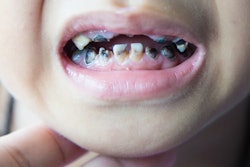
When it comes to preventing early childhood caries, 2 years old may truly be too late. A new study found 3-year-old children who received dental care from infancy had significantly better oral health than those who started getting care at 2 years of age.
The study focused on the impact of early intervention efforts for more than 400 indigenous Australian children, but some dental researchers believe the findings are relevant for health providers who see children from all backgrounds. In an invited commentary, Paul Casamassimo, DDS, and Arthur Nowak, DMD, said the study findings demonstrate the importance of including dental care in early childhood health promotion. Both the study and the commentary were published on March 15 in JAMA Network Open.
"The study's two main findings were the benefit to the early intervention group and the need for periodic reinforcement," wrote Drs. Casamassimo and Nowak, from the Ohio State University College of Dentistry and the University of Iowa College of Dentistry, respectively. "Both are concepts and practices amendable to pediatric primary care and general dental practice but which remain largely underused in developed countries despite growing evidence, as in this report, of significant clinical benefit."
The long-term impact of early intervention
Poor oral health in childhood is associated with pain, poor nutrition, and missed school days. As a result, researchers are eager to find ways to prevent early childhood caries, especially for at-risk populations.
In the study, Lisa Jamieson, PhD, a researcher at the University of Adelaide Dental School in Australia, looked at whether early interventions could help prevent caries in Aboriginal and Torres Strait Islander children, who experience almost twice as much untreated decay as their peers. It was a follow-up to a previous study, also led by Jamieson, with the same cohort of children.
In the original study, Jamieson and colleagues randomly divided these children into two groups: immediate intervention and delayed intervention.
- In the immediate intervention group, the children received fluoride varnish at 6, 12, and 18 months of age. Their mothers also received dental care during pregnancy and motivational interviewing from a trained professional.
- In the delayed intervention group, the children and mothers received the same interventions as the immediate intervention group. However, they received them when the children were 2 years old, as opposed to infants.
The original study looked at the oral health of these children at 2 years of age, when half of the children had received an intervention and half had not. In the present study, Jamieson and colleagues followed-up with both cohorts of children one year later, when they were 3 years old and all participants had received the interventions.

In the original study, children who received the early intervention showed better oral health than those in the delayed intervention group, and the same was true in this study. The children who received interventions as infants had less untreated decay and fewer decayed, missing, or filled teeth (dmft) than children who received care just two years later.
However, the oral health of the children who received delayed care was likely still better than it would have been without any interventions, the researchers noted. Without any interventions, these children would have an average of 2.13 teeth with untreated decay by the time they were 3 years old, they predicted.
These findings support the notion that early childhood caries interventions likely have a positive effect, even if they don't start at infancy, Drs. Casamassimo and Nowak noted in their editorial.
"Infant oral health pays it forward," they wrote. "Cumulative studies support long-term benefit, even if started at ages older than those in the study by Jamieson et al."
Calls for early oral health promotion
This follow-up study had a number of strengths, including that the intervention groups were randomized and the clinicians who evaluated untreated decay and dmft were blinded to the groups.
However, it also had several shortcomings. The researchers could not evaluate the effect of the third and final fluoride varnish treatment for the delayed intervention group, as it took place after the children had turned 3. They also could not account for some factors that influenced the children's oral health, such as trauma or disruptive family situations.
While the findings may not be directly applicable to all groups of children or even other indigenous children in different regions, the authors still believe the findings demonstrate the importance of early oral health promotion efforts. In their letter, Drs. Casamassimo and Nowak agreed.
"The report adds to our knowledge and should inspire us to see young children, who clearly can benefit from this intervention, particularly minority children and those who live in poverty," they wrote. "Dental caries affects these groups disproportionately."



















